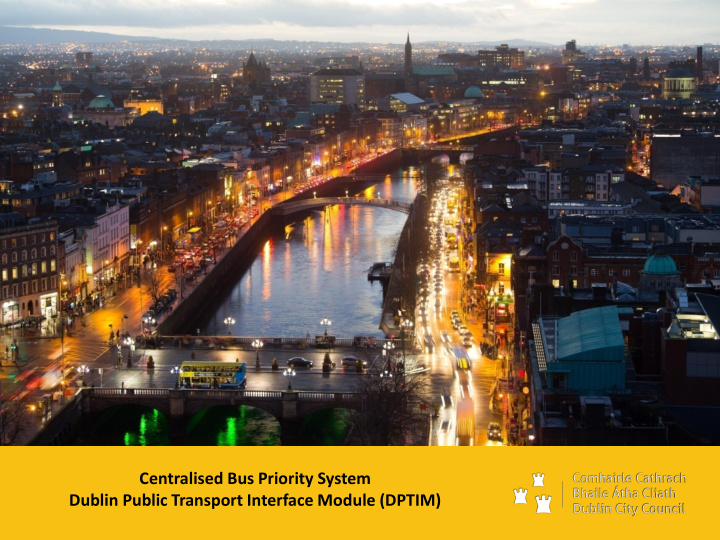



Centralised Bus Priority System Dublin Public Transport Interface Module (DPTIM)
Background • D ublin P ublic T ransport I nterface M odule. • Building on existing SCATS infrastructure. • Centralised system - No extra onsite equipment necessary. • Virtual Detector configuration. • No extensive civil works required. • No additional cost to quantify performance of bus services for other projects. • Allows for network bus priority – multiple traffic junctions. • Project consists of DPTIM Interventions, Signal Optimisation and Light Civil Work. Screen shot from DPTIM interface
System Architecture Centralised Bus Priority System Real time XML data feed Data Analysis – Virtual Detector Placement Tableau MS-SQL Reports Dublin Bus Data
Display – all buses currently on a route that services bus stop 315 Bachelors Walk
Each bus position bring the following information; • Route information < 16> • At a stop and stop details < 1354> • Schedule deviation: <-10> • In Congestion : <False>
Reporting – Bus positions
Reporting – Bus positions
QBC Performance Reports Bus Performance Report – Segments of a Quality Bus Corridor Drill into segments using bus position data reveals pinch points
Unscheduled Stops Report Bus Performance Report – Unscheduled Stops Report Ranking on frequency to delays on approach to bus stop Time band Rank Stop Name Stop Stops Trips % Average Average Impact No. Stop Distance time 16:00-19:00 1 Whitworth Road David Road (+) 00837 168 137 123 57 138 9587 16:00-19:00 2 Parnell Square Rotunda Hospital (+) 00007 62 143 43 87 197 5373 16:00-19:00 3 Westmoreland Street Fleet Street (+) 00319 60 77 78 73 79 4407 16:00-19:00 4 High Street St. Auden's Church (+) 02001 50 76 66 68 73 3385 16:00-19:00 5 Dorset St Eccles Place (+) 00014 45 139 32 72 52 3235 16:00-19:00 6 Mckee Avenue Finglas Village (-) 04938 28 69 41 88 -52 2463 16:00-19:00 7 Cardiffsbridge Rd Cappagh Road (+) 04583 34 71 48 72 36 2462 16:00-19:00 8 O'Connell St Henry Street (+) 00279 42 74 57 58 184 2449 Mapping the bus position on approach to the Bus Stop data reveals pinch points
Bus Lane ends due to Road Capacity Location of Delays Green – Before Stop Purple – After Stop
Bus Lane ends due to Road Capacity Location of Delays Green – Before Stop Purple – After Stop
Bus Lane ends due to Road Capacity
Bus Lane ends due to Road Capacity – Use DPTIM Virtual Detector(s)
Bus Lane ends due to Road Capacity – Use DPTIM Virtual Detector(s)
Camden Street – Delays due to lack of road capacity Location of Delays Green – Before Stop Purple – After Stop
Camden Street – Delays due to lack of road capacity Location of Delays Green – Before Stop Purple – After Stop
Camden Street – Delays due to lack of road capacity Location of Delays Green – Before Stop Purple – After Stop
2017 - January 2016 - January
2016 January 2017 January
Virtual Detector
Virtual Detector in operation
Results – Virtual Detector in Operation
Results - Blanchardstown
Clondalkin QBC • 14 DPTIM detectors. • 6 junctions added to SCATS. • 1 junction personality change. • Signing and lining.
Results - Clondalkin QBC
Results - Clondalkin QBC
Results - Clondalkin QBC
Whithworth Rd – Review
Whithworth Rd - Review
Lining and other civil work
Clarehall/Malahide Rd Inbound bus stuck in traffic during AM/PM Limits the possibility of assisting inbound buses in PM via DPTIM intervention.
Clarehall/Malahide Rd Lane reassignment allows extension of bus lane and reduction in delays during peaks.
Results - Clarehall
Results - Clarehall
Swords Road Before installing Bollards to protect Bus Lane
Swords Road Before installing Bollards to protect Bus Lane
Swords Road Installing Bollards to protect Bus Lane
Swords Road After installing Bollards to protect Bus Lane
Swords Road After installing Bollards to protect Bus Lane
Swords Road After installing Bollards – Reports From Dublin Bus
Conclusion • Opportunity for Complete Corridor Analysis. • Bus Performance quantifiable via the Bus position data/reports. • Complements existing methods: Light civil works Traffic signal optimisation • Amendments are configurable. • Highly effective, low cost method. • How the City is Performing.
Conclusion • Opportunity for Complete Corridor Analysis. • Bus Performance quantifiable via the Bus position data/reports. • Complements existing methods: Light civil works Traffic signal optimisation • Amendments are configurable. • Highly effective, low cost method.
Conclusion • Opportunity for Complete Corridor Analysis. • Bus Performance quantifiable via the Bus position data/reports. • Complements existing methods: Light civil works Traffic signal optimisation • Amendments are configurable. • Highly effective, low cost method.
Conclusion • Opportunity for Complete Corridor Analysis. • Bus Performance quantifiable via the Bus position data/reports. • Complements existing methods: Light civil works Traffic signal optimisation • Amendments are configurable. • Highly effective, low cost method.
Conclusion • Opportunity for Complete Corridor Analysis. • Bus Performance quantifiable via the Bus position data/reports. • Complements existing methods: Light civil works Traffic signal optimisation • Amendments are configurable. • Highly effective, low cost method.
Recommend
More recommend